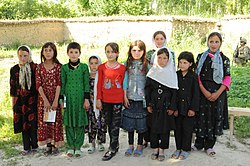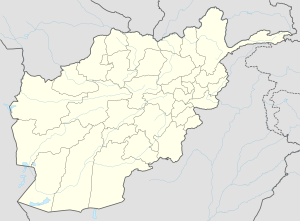|
Khwahan, Afghanistan
Khwahan (Persian: خواهان; Tajik: Хоҳон) is a town (and a fort) and the capital of Khwahan District, in Badakhshan Province in northern Afghanistan.[1] It is located on the left bank of the Panj River, subregions of Darwaz.[2]  HistoryAfter Alexander the Great overthrew the Persians, the area came under the rule of [3] the Greco-Bactrian king Euthydemus I and his son Demetrius I[4] The village has a fort called Qala Khwahan. The fort is made of mud, in the shape of a square with three bastions on each face, with a capacity of 500 to 600 individuals. It is similar to most other forts in the area. For about two miles in each direction is cultivated land.[2] The village contained roughly 160 houses around the turn of the 20th century.[2] The inhabitants of this area speak Dari Persian and are Sunni Muslims; and engage in agriculture. They grow buckwheat, red and white barley, sesame, zucchini, corn, mung beans, peas, beans, potatoes. Geography The area is mountainous, with Kuh-e Kallat a prominent mountain in the district. This peak is 4090 meters high above sea level. The town sits on the Panj River and is one of very few Afghan towns with Tajikistan to its south. Road access is to Kulob, Tajikistan. ClimateKhwahan’s climate is humid continental (Köppen Dsb), with an annual mean temperature of 9.4 °C (48.9 °F). September is the driest month, with 19 millimetres (0.7 in) of rain. In May, the precipitation reaches its peak, with an average of 172 millimetres (6.8 in).
References
External links
|
||||||||||||||||||||||||||||||||||||||||||||||||||||||||||||||||||||||||||||||||||||||||||||||||||||||||||||||||||||||||||||||||||||||||||||||||||||


